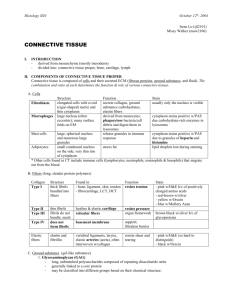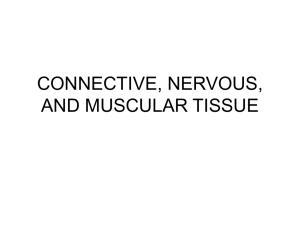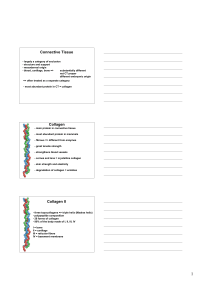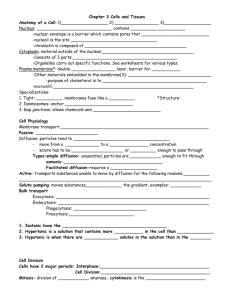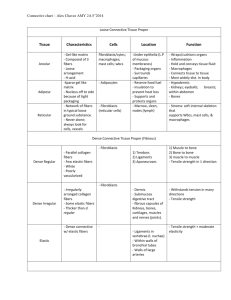CONNECTIVE TISSUE
advertisement
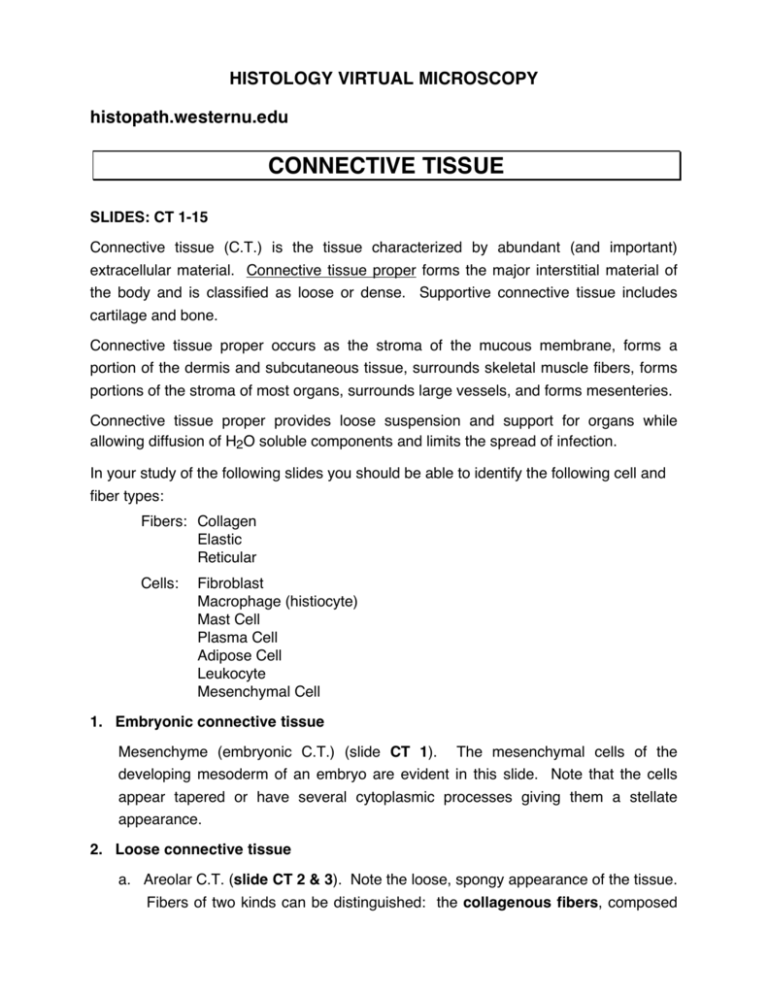
HISTOLOGY VIRTUAL MICROSCOPY histopath.westernu.edu CONNECTIVE TISSUE SLIDES: CT 1-15 Connective tissue (C.T.) is the tissue characterized by abundant (and important) extracellular material. Connective tissue proper forms the major interstitial material of the body and is classified as loose or dense. Supportive connective tissue includes cartilage and bone. Connective tissue proper occurs as the stroma of the mucous membrane, forms a portion of the dermis and subcutaneous tissue, surrounds skeletal muscle fibers, forms portions of the stroma of most organs, surrounds large vessels, and forms mesenteries. Connective tissue proper provides loose suspension and support for organs while allowing diffusion of H2O soluble components and limits the spread of infection. In your study of the following slides you should be able to identify the following cell and fiber types: Fibers: Collagen Elastic Reticular Cells: Fibroblast Macrophage (histiocyte) Mast Cell Plasma Cell Adipose Cell Leukocyte Mesenchymal Cell 1. Embryonic connective tissue Mesenchyme (embryonic C.T.) (slide CT 1). The mesenchymal cells of the developing mesoderm of an embryo are evident in this slide. Note that the cells appear tapered or have several cytoplasmic processes giving them a stellate appearance. 2. Loose connective tissue a. Areolar C.T. (slide CT 2 & 3). Note the loose, spongy appearance of the tissue. Fibers of two kinds can be distinguished: the collagenous fibers, composed of large wavy bundles of extremely fine fibrils, and the scarcer elastic fibers, which are very long, thin, branching and not subdivisible into fibrils. Between the fiber meshes may be seen a variety of different cells. The two most abundant types are fibroblasts and macrophages. Generally, it is difficult to distinguish one from another. The tissue in slide CT 3 had been treated with trypan blue, a vital dye that was phagocytosed by the macrophages. Therefore, cells containing blue material may identified as macrophages. Along the course of blood vessels and in areas where fat is present may be seen large mast cells which are easily recognized by the coarse and intensely staining granules which completely fill their cytoplasm. Lymphocytes, eosinophils, and plasma cells may also be found (the latter, rarely). b. Esophagus (CT 4). The connective tissue of the esophagus between the epithelium and the muscle has a scattering of elongate nuclei between pink collagen fibers. c. Duodenum (CT 5). The connective tissue under the epithelium will demonstrate namy of the connective cell types. 3. Dense irregular connective tissue Large collagen fibers arranged in an irregular meshwork. Fibroblasts are common with other cells less common. The fibroblasts will generally show small, oval, densely staining nuclei among the collagen fibers. Palmer skin (CT 6) and Scalp (CT 7). Beneath the epidermis (stratified squamous epithelium) is tissue which has relatively few cells. Fibroblasts are widely scattered; groups of cells are usually associated with vessels. Finer collagen fibers are near the epidermis, coarser fibers are deeper. 4. Dense regular connective tissue Dense regular connective tissue is found in tendons, ligaments, and aponeuroses and can be made principally of collagen or elastic fibers. Dense elastic tissue may be found associated with in ligaments, however, dense collagenous is predominant in tendons. a. Tendon (slides CT 8, 9 & 15). The collagen fibers are parallel with long, thin fibroblast nuclei interspersed between them. b. Yellow elastic fibrous tissue (CT 10). This is a section from the ligamentum flavum located between the vertebral laminae. Notice that the elastic fibers are wide as compared to collagen fibers. 5. Adipose connective tissue Some unilocular fat cells are found in any loose C.T., but where it occurs in vascularized lobules, it is termed adipose tissue. Adipose C.T. (CT 11 & 12). Note the large cells that both synthesize and store fat. The cytoplasm of the mature cell is little more than a peripheral ring due toi the peripheral location of the cytoplasm. Nuclei are flattened. The contents of the lipid vacuole have been removed during preparation. 6. Reticular connective tissue This is the fine C.T. that surrounds the individual cells of many organs and is the stroma of hematopoietic and lymphoid organs. The reticular fibers are not easily distinguished from collagen fibers in routine H & E preparations and must be specially stained for. Reticular tissue (CT 13). The fine fibers of reticular C.T. are shown in this silverstained preparation of a lymph node. 7. Blood Blood is a specialized connective tissue in which the extra cellular material is a fluid and fibers are only present during the clotting reaction. Human blood smear (CT 14). In this slide be able to identify the following formed blood elements. l. 2. 3. 4. 5. 6. 7. Erythrocytes (RBC) Neutrophils Eosinophils Basophils Monocytes Lymphocytes Platelets



